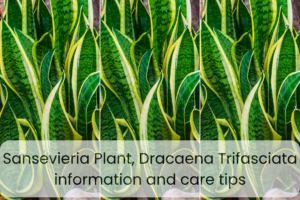Would you like more information on the Sansevieria plant and how to care for it?
This post is all about the lovely Sansevieria plant aka Dracaena trifasciata and how to care for them.
Starting a new garden or plant collection can be very exciting but sometimes the information surrounding plant care can be overwhelming. The best place to start is with plants that are low maintenance. Sansevieria plants are low maintenance and beautiful. They were once called Sansevieria trifasciata but they were recategorized in the last few years into the Dracaena family.
After learning how to care for these lovely plants you are going to be a pro at growing them and perhaps you will teach some of your friends!
This post is all about the beloved Sansevieria plant and how to take care of them.
Sansevieria Plant aka Dracaena trifasciata
The Snake Plant (Sansevieria plant, Dracaena trifasciata) is also known as mother-in-law’s tongue or bowstring’s hemp. It has become increasingly popular in recent years. This plant is native to West Africa and reaches to a height of about three feet and a width of two and a half inches at its peak of maturity. There are some great benefits to keeping these plants indoors. They are beautiful, easy to care for and they aid in air purification inside your home. They also exist in a plethora of varieties to compliment various personalities.
The standard snake plant is usually dark green with light green splotches. Other varieties include: “moon glow” or “moon shine” (sansevieria craigii, jacquinii, and laurentii superba) which are a bright greenish silver color, sansevieria trifasciata ‘laurentii’ which are green with golden edges.
The extant varieties of snake plants on earth provide excellent air purification within the typical indoor situations. Which makes these plants the perfect addition to your home, office, schools and the like. In a study conducted by Wolverton of N.A.S.A. 1993 it was determined that Sansevieria Trifasciata was effective at removing airborne pollutants such as formaldehyde, ozone, and ammonia and xylene, to name just a few. Since newly built/remodeled homes emit hundreds of chemicals over a long period of time (5-15 years in some studies), indoor air pollution is a much greater risk to human health than most people realize. An excellent solution to this problem is to keep live plants in and throughout the homes/schools/offices in which we reside. Plants of this nature are especially beneficial to those who suffer from breathing conditions such as asthma. They are known to release oxygen at night which helps improve one’s quality of sleep. Our bodies are known to heal the most during rest so we can deduce that cleaner air conditions lead to faster healing.

How to care for your Snake Plants
Most varieties of snake plants prefer to have well-draining soil. You can use any potting soil and mix perlite to increase drainage otherwise you can buy a premixed soil that is labeled for cacti or succulents. Since they are drought resistant, it is sufficient to water them about once every two weeks and allow the soil to completely dry out prior to watering them again. However, if you have them in a pot and you live in a drier region they may dry out sooner than two weeks.
These plants prefer bright, indirect sunlight but can survive in low-light conditions. If you keep them in low-light areas try to move them to brighter rooms or even outside for a few days once in a while and bring them back when they perk up. They work well in dimly-lit bathrooms, bedrooms and corridors.
Whale fin is a rare item. Sansevieria Masoniana reaches about four feet at maturity and is a slow-growing snake plant cultivar. The tallest known species are native to Central, West and North Africa depending on the variety. These plants are categorized as succulents and take minimal effort to keep healthy.
If you are interested in purchasing a plant for your home please click here to see our inventory.
IG: @Jarahk07 @SapphireVine
Pinterest and Etsy: SapphireVine
